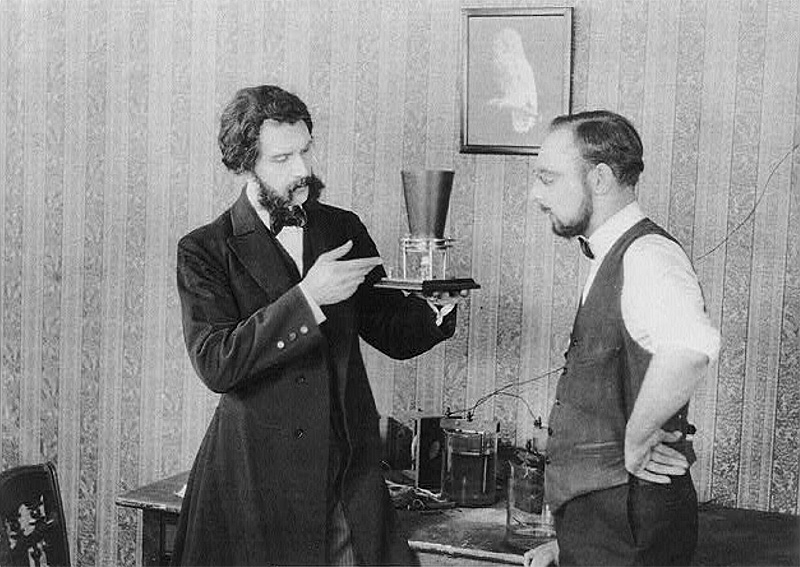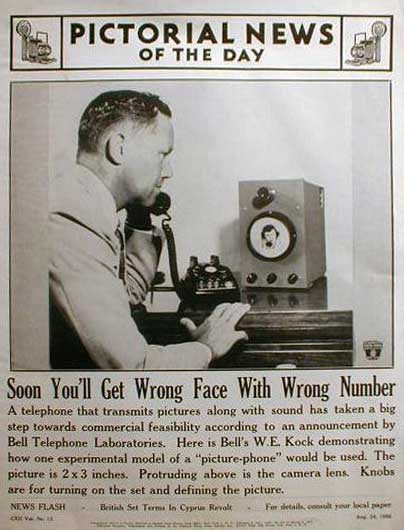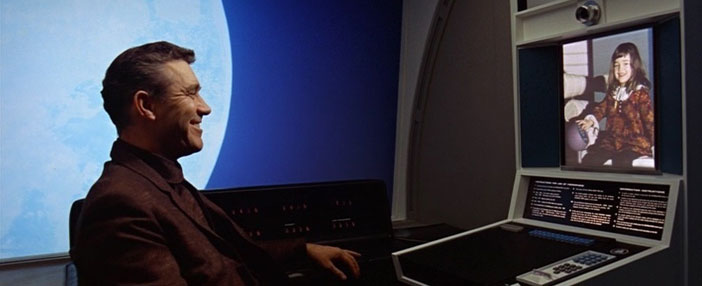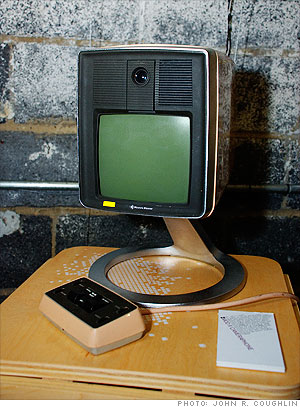|
The History of AtariTel (Content is from Atari Inc. Business is Fun and is protected under copyright law. Copying and use is not permitted without express written permission by the authors.)
Alexander Graham Bell made the historic statement "Watson, come here. I need you," in 1876. His assistant, Watson would hear the words come through his prototype telephone speaker, causing him to come into the room where Bell had just spoken into his prototype telephone microphone - the birth of the telephone had taken place.
Within only two years, the imagination of George du Maurier would evolve the concept with a sketch of a man sitting, having a conversation with a woman seen on a projection screen who was also holding a phone and they are having a visual conversation. By 1910, a French postcard depicting very much the same scene was created stating that this was what the telephone would be in the year 2000.
Bell Laboratories was already researching video telephone technologies in the late 1920s, and the vision is further fueled by the 1927 movie "Metropolis" in a scene of two men talking on huge wall sized telephone system with a small video screen so they could see each other while talking through standard telephone handsets. Bell Laboratories set up a demonstration of its Picture-Phone" between Los Angeles and New York in 1956, finally showing the vision of communicating by live images to be a reailty.
The system actually required three dedicated specialized phone lines; One line each for video to New York, one to Los Angeles and a third line for the audio conversation was then required and all of these dedicate lines had to be synced together across the telephone carrier's network.
The really big public awareness of videophones would come at the 1964 World's Faire in New York where demonstrations between New York and Washington DC were shown. Just as the earlier picturephone prototypes required three special dedicated lines, the 1964 system did as well. Bell Labs attempted several commercial installations of the picture-phone networks into New York, Washington DC and Chicago, however at the cost of up to $27 per minute for a call the product ultimately failed.
Despite the real world commercial failure of the picture-phone due to its specialized infrastructure needs and its overly expensive cost, the public still became captivated by the idea of one day being able to have actual video phone calls.
This would reach new heights as the result of the futuristic cartoon show The Jetson"s when it aired in 1962, making video phone calls a common occurrence in almost every episode. In 1969, Stanley Kubrick's science fiction fantasy "2001: A Space Odyssey" would also show a very realistic scene of a father placing a video phone call to his daughter on what the movie would depict as being an AT&T public payphone in the future.
Only further inspired by all this, AT&T with its research and marketing muscle as well as large coffers of financial resources to tap into, would not give up this uphill battle to take videophones from fantasy to commercial viability. In 1970, AT&T would try it once again with its Picturephone II system and network in Pittsburgh, Pennsylvania. Just as quickly however, it would silently admit defeat and shut it down as the Bell telephone giant would step back and not make another attempt for almost 15 more years.
In the foothills of the California Sierra Mountains in 1976, back in the Grass Valley Research and Development Lab, the Cyan engineering team decided to take up the call. Called "Phoney," it"s a remarkable design for video transmission technology. "Bear in mind that we did not have DSP chips and a lot of cheap memory available, so it was a challenge to do anything practical," recalls Larry Emmons. The concept design and ideas are shown to Nolan Bushnell and Joe Keenan, at which point Joe came up with the idea that this could be an entertainment-based device, basing the design around a toy instead of something for business or commercial use.
With that in mind, Larry Emmons, Dave Stokes and Michael Cooperhart begin work on building a simulation prototype. While Larry and Dave worked on the engineering side, Michael became the Project Concept Manager - after all, he was hired to do project management and industrial design and to help get projects (specifically the video project) funded and into production. The video project certainly needed a kick start and funding!
When Michael first saw the project in the lab it was just a small 16 x 16 image on a 19-inch open frame monitor, and he immediately knew what was needed was a demonstration prototype and a funding proposal. Moving forward, the team built the demonstration prototype, consisting of two desktop base units that were each wired across the lab into a card cage system holding all of the electronics. Since this was just for the very early stages of product development, its physical size and the need to be able to easily pull out a section to work on, made it a large system requiring a card cage box for all of the major electronic components to reside in.
Unlike AT&T's efforts, the initial prototype didn"t actually use a telephone line, but instead used a dedicated wiring system that ran from one office on one side of the lab floor to another office way on the other side of the lab floor. However, to make sure that eventually the product could be compatible with the standard telephone line systems of the day, it was restricted to data rates and capabilities that were possible at the time (modeling capabilities after fax machines which were just out and very were expensive).
Larry Emmons and the Cyan team came up a this theory that telephone conversations had some degree of down time, with pauses between words being spoken where they might be able to insert picture data to transfer. Their test vehicle worked quite well, and the limited resolution photos sent one person"s image at a time; first person A's picture was sent from one end of the link, when that completed the process was reversed. With this setup, voice had priority over the picture, and the remote photo would be received line by line during lapses in audio. One afternoon, Nolan and company traveled to Grass Valley for a demonstration of the picture phone during their regular checking of the status of Cyan's projects. When it came time to demonstrate the phone, they had one part of it set up in the main office, and the second part in a back lab. Everyone played with it for awhile and had a good time testing it out, but as they retired to the main office, Nolan abruptly disappeared. The demo was still active with empty photos being exchanged on the device, when suddenly during their conversation Lanny Netz noticed a troubling and disturbingly recognizable object coming in on the video feed.
Trying to divert everyone's attention from the screen, Larry kept everyone talking while he tried to block the incoming image by using up all of the priority data transfer. However, the inevitable occurred: The image fully processed onto the screen for everyone in the front office to discover where Nolan had disappeared to and what he was doing. The site of Nolan's rounded ass cheeks were what greeted the room full of people, a digitized mooning! Not quite the same historic reverence as the famous Bell & Watson "Come Here!" moment in telephone history, but certainly a memorable, landmark (and classic "Atari-style") moment for all who were present for this graphic "full moon" eclipse!!!
After the demonstration, Ron Milner (though not involved in the project) needed a power supply to use for a different project and the demonstration system had a perfect power supply that he could use. Proceeding to disconnect the power supply, he unknowingly let the 110v "hot" wire which was still live touch the 5v line on the card cage. The result was a room full of fireworks and smoke, as each of the cards proceeded, almost in a queued fireworks sequence to spark, to smoke and burn out. "It was quite a fireworks show. Luckily it didn't burn the lab down or set off the sprinkler system," recalls Ron Milner.
As for courting funding from Atari for a project such as this, Michael became so successful in this process that he gained the nickname Michael "Corporate- Hart" of which he was actually proud to hold the title of. Someone had to help get these great ideas funded and into production and Michael would become the man behind the curtain whose job it was to glorify the great work being done by Cyan. Although work continued on "Phoney," by 1979 it's moved to Cyan's backburner and then added to a Grass Valley Project Summaries document under the category, "Disasters."
However in 1981, "Project P" (as it is now called) makes a comeback when in the engineering summaries for that year it's dryly noted, "try it again."
This new interest may have been prompted by Steve Bristow's new division called "Ataritel," put together to bring Atari into the consumer telephone market with a series of high tech phones with never before seen features. Bristow sees "Phoney" as a compliment to the new division, and the still separate video phone project becomes known under Ataritel as Eagle or alternately Eagle Eye.
By the end of the 1970s and into the early 1980s, a great many homes were still using rotary dial phones because of the still uneasy process of getting a touchtone phone. First, you had to order touchtone service for your telephone line and depending on your area, that could cost an extra $2 to $5 per month. Then once you had touch-tone service, you could look to rent a touch-tone phone. That's right, rent - these were the days you couldn't buy your phones, you had to rent them from Bell Telephone. And once you ordered your upgraded phone line and phone, then a Bell telephone technician would come to your home and install it for an additional fee. Hopefully you get the point that there was a market ripe for competition here.
Why were there so few compeitors? Originally, Bell Telephone would not allow any non approved telephones to be plugged into its network or to even allow any modifications to its devices. In 1956, a lawsuit was won against Bell Telephone that would allow the use of non-Bell Telephone devices and the modification of Bell Telephone devices as long as there would be no damage caused to the network or its devices. Unfortunately, save for novelty phones and big business, the stigmatism of only Bell telephones meaning quality still sat in the eyes of the average consumer. It didn't help that during any service calls or installation of new outlets by a Bell serviceman, the service call was accompanied by an installer telling the homeowner that plugging in phones not purchased from the telephone company could cause problems with their service and any service calls could be very expensive. This subtle pressure tactic would be used often in trying to sway people away from going it on their own.
Atari's entry into the telephone market began when Steve Bristow begins to assemble his new consumer research and development team in 1981, one of the technologies that intrigues Steve and his team were wireless intercom systems.
So they start to look at the possibility of doing something like that with telephone applications. They build a prototype line system and bring it out to Warner Communications in New York to demonstrate to Manny Gerard and Steve Ross. Not only is Warner interested in the prototype and the demonstration, Steve's consumer research and development group is also now assigned to be Atari's new telephone division called "Ataritel." The idea of developing a line of phone systems that would provide such luxury features to an eager buying public was not to be ignored. Atari engineers could see this need, and Warner Communications fully supported the idea of its high tech subsidiary branching out into this field " a field which would certainly be a strong profit center by delivering much wanted and needed conveniences to homeowners. Marketing and management at Atari, who had many times shut down numerous game products out of fear they could impact sales of the Atari VCS, also welcomed this new product line. The fact it would not be entertainment-based meant it would not compete in any way with the Atari VCS or its cartridge sales - or more importantly their bonuses.
The planned line of telephones will offer advanced features not commonly seen at the time, such as redial, call waiting switch, mute, hold and a full duplex speakerphone which would allow both parties to talk and hear each other at the same time. Not a problem today, this was a very difficult technological hurdle at the time and would give the product line a huge feature selling advantage. There is also talk of possibly incorporating home control features, but another very advanced design called "power line transmission technology" is instead pursued for what will be called the "Telectra" line of telephones. Many homes were only wired for telephones in specific, high traffic areas - generally in the kitchen as the primary phone and a phone in perhaps a den or living room, and maybe in the main bedroom. This usually posed a problem for the new home telephone market, as you would still be at the mercy of the telephone company to have to come into your home and charge you to run additional telephone outlets in other areas of the home. Atari knew that in order to get into homes in any volume, they would have to win over the hearts and minds of the consumer by giving them easy to use yet high-tech features far ahead of Bell and everyone else. Most importantly, power line telephone systems would be their solution to get past Bell's control of the phone outlets in the home. A power line telephone system consists of a Master Station which plugs in to the already existing telephone jack and into a standard wall outlet. The catch is, the outlet isn't just for power, but is also used for communication with a set of satellite phones. The master station would essentially be set with its own home telephone network, allowing the homeowner to buy additional extension phones and set them to the same network setting as the master station. All you would have to then do is plug the extension phone-set anywhere in the home into a power outlet, pick up the receiver and you would now have telephone service in that room. Now a homeowner could take a call in the kitchen, place a person on hold, and then go into their office or another room, pick up the extension set and have their conversation.
The phones could also act as intercoms between rooms as well. For the next two years the product engineering and designs would evolve. Porsche Design and Morison Cousins Associates would be contracted to provide design services and give the new products a unique and state of the art look. The designs by Morison Cousins are chosen for their "Space-tel" look which have very clean, attractive and appealing high tech presence. They're also easy to use and are designed to fit the many different functions that the various models and product lines will need to accommodate.
By March 1983, after nearly two years of working in secret, Atari announces its new secret division to the public. To add an additional air of mystery to the whole affair, Marketing, which is handled by Dick Mier, releases a Press announcement that the entire division has been secretly operating under the codename "Project Falcon."
In fact, unlike previous Atari products that usually had their codenames after women, the Ataritel product codenames were all after birds - Falcon, Eagle, Pudgy and Parrot. An effective marketing campaign is launched, featuring the Ataritel name covered under a tarp; you could clearly read the name, but it gave the perception to everyone that there would be so much more revealed when the wraps came off. Marketing specialist Kim Soulek would demonstrate the prototype designs at numerous events and tradeshows throughout the year, including the Telephone Show in San Francisco.
Unfortunately, shortly after the showing a number of events occur surrounding the appearance of James Morgan, Atari's new CEO who takes over the reins of the company from Ray Kassar after massive financial losses. After a month long evaluation period, James begins to cut projects and products across the board that he feels are not necessary to Atari's recovery. Ataritel will be one of those projects. Initially, its staff is cut back in September, but by October most of the division staff has scattered to other projects and departments or they have left the company all together. Internally, Ataritel is shuttered - even Steve Bristow has moved over to the Home Computer Division to work with Dave Stubben on refocusing the division's product strategy and map out new computers and products for the next two years. The phones of the future will not get their chance to be released in the future and Ataritel, treated like an unwanted phone call, is put on permanent hold. A glimmer of hope for the product line was seen in April, 1984 after a simple announcement that Atari is still considering a release of its line of Ataritel products. But other than this announcement, nothing actually ever comes of it. Word also reaches Cyan that the Ataritel project has been canceled and their work on "Project P" has been canceled along with it. The video phone too will not get its chance to make it out of Cyan's lab and into the hands of consumers. The Falcon, Eagle and the nest eggs have all been grounded.
During the turmoil of 1984 and the sale of the Consumer Division (which includes the Home Computer Division) to Tramel Technologies, Ltd. on July 2, 1984, the Ataritel division is retained by Warner Communications along with the Coinop Division and the Atari Adventure Centers division. The former management of Ataritel tried to see if they could purchase the division outright from Warner and spin it off as an independent company separate from Warner. Warner, unfortunately, would not agree to the terms of the offer. Seeing the value in Ataritel's assets and specifically the video phone product, Manny Gerard negotiates to sell the product to a company called Medama, which was a newly formed U.S. subsidiary of Mitsubishi Electric established as a development and marketing company for the U.S. market.
While looking to take Ataritel independent, Roy Elkins approaches Medama for funding and after Warner won't spin off the division he makes the introduction to Manny Gerard about purchasing the rights, IP and assets to the videophone project. During one of the demonstration meetings with Warner, Ataritel and Medama, the Cyan videophone is set up in the Warner conference room in New York. Back in Grass Valley, Michael Cooper-Hart is preparing to send a video transmission to demonstrate the product to the Mitsubishi team from Japan. Cyan's Larry Emmons is also on hand for the meeting, so he initiates a videophone call with Michael Cooper- Hart. Michael is on the speakerphone and tells Larry that a friend dropped by to see him and an image of a Playboy centerfold begins to appear on the screen in the Warner conference room. The room breaks out in laughter, and that pretty much seals the deal to move forward with negotiations to purchase the video phone product.
During negotiations, Manny quickly discovers there is a leak - that Stan Zawadowicz, who is acting on behalf of Medama, knows entirely too much about the product including things not released in documents or prevously discussed. Manny decides to use this leak to his advantage; He begins to discuss internally within Warner and the Ataritel team that Warner has received a far more generous offer for the videophone project and that he is considering negotiating with this other firm instead. Zawadowicz suddenly comes back with a higher offer and Manny jumps on the turnaround of the situation by selling the rights, IP and assets of the video phone project to Medama for a much higher price than he originally planned. The original video phone team, consisting of Larry Emmons, Michael Cooper-Hart, Chris Wright and Roy Elkins will be joined together again over at Mitsubishi's new U.S. subsidiary to take their work on the Atari video phone and refine and complete it under new design guidelines and feature requirements outlined by Mitsubishi. They're joined by an old familiar face from many years ago, Nolan Bushnell's former boss from AMPEX, Kurt Wallace. In 1986 the videophone is finally released as the Mitsubishi Lumaphone.
|






